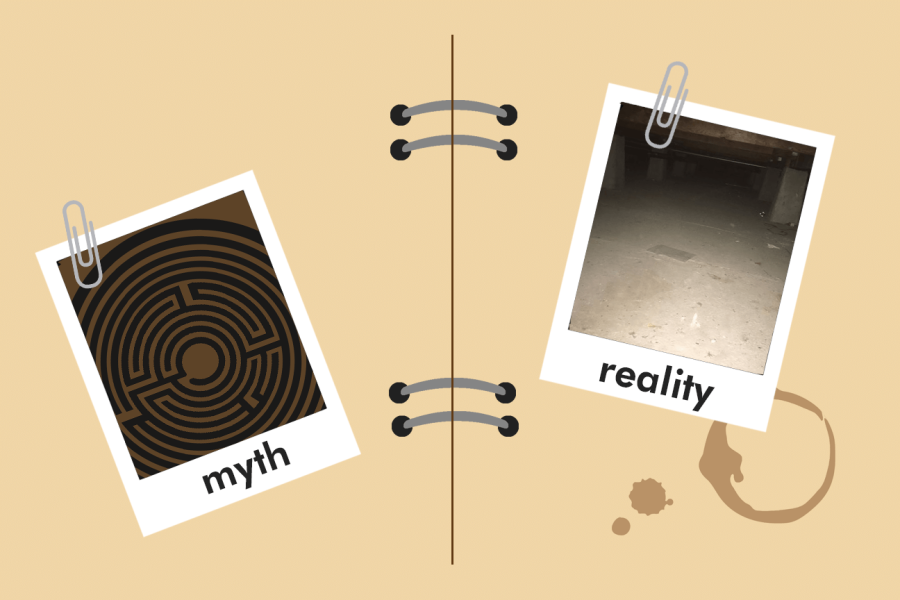A bomb shelter? Tunneling through Lynbrook’s myths
May 3, 2019
Does a subterranean tunnel system exist under Lynbrook? Spurred by comments from economics and U.S. government teacher Jeffrey Bale, two Epic writers were eager to determine the truth behind this rumor.
Built in 1965, during the Cold War era, Lynbrook was initially an overflow school for Cupertino High School. Lynbrook has had a long history of construction, as the gym, locker rooms and swimming pools did not exist the first year the school opened. The 100-wing, which now houses the physics classrooms, used to be the library. It was only in 2008 when the current football field, track and bleachers were added, along with solar panels in the parking lot. Construction continues today, with the renovation of the quad and cafeteria that started in fall 2017.
Rumors of a series of tunnels, and even a bomb shelter underneath the 600-wing, are some of Lynbrook’s most well-known myths. The basis of these myths likely comes from the fact that Lynbrook was built during the Cold War. Some think that a full-fledged tunnel system and bomb shelter exists; others believe them to just be crawl spaces or storage areas, or to not exist at all.
According to custodian Henry Avecilla, the tunnels are probably underground spaces for the sewer and communication lines, as he has seen electricians access these passageways when they perform maintenance on the school’s wiring.
“Sometimes, [electricians] open up the tunnels and use them to get to the communication lines,” Avecilla said. “I’ve looked down and seen a lot of wires, but I’ve never been down there.”
Skilled Maintenance Technician Ben Ochoa has been in these maintenance tunnels, and he confirmed that the bomb shelter are just a myth. The tunnels are, in fact, crawlspaces used to access electrical systems, plumbing and heating ducts.
“[The tunnels are] for [electricians and maintenance] to be able to service and repair anything that needs to be fixed,” Ochoa said. “Things don’t really last like folks think. The building might last hundreds of years, but the piping and the electrical [systems] have a tendency not to last.”
Crawl spaces exist under every building at Lynbrook, excluding the gym and fieldhouse, and are dark, cramped, dirty and lined with rat traps.
“There’s not a whole lot of fun or reason to be down there,” Ochoa said. “There are a lot of spiders, that’s for sure. An occasional rodent.”
Ochoa has heard the myth about the bomb shelter and tunnel system and thinks that it originated from a teacher who spread the rumor to give students something to talk about. However, he has worked at other schools in the district, such as Cupertino and Homestead, that have larger crawl spaces that connect the entire school. “The [crawl space] at Homestead went the length of the campus and to each wing, from the boiler room all the way to the other end of the campus,” Ochoa said. “It had a bunch of little branches, and you could walk in it. But it wasn’t for a bomb shelter; it was just for utilities.”
Since the rumor about the bomb shelter was first heard from Bale, it was crucial to include his input. Bale attended Lynbrook from 1996 to 2000 before returning to teach, and said that the legend of the tunnels has existed since he was a student.
Bale attributes the ease with which rumors spread when he was a student to the lack of the internet and smartphones, and the deeper connection students had with their high schools. With no phones for taking and sharing photos instantly, students relied on word-of-mouth to spread information. Additionally, with more free time and more students staying in the Lynbrook neighborhood after graduation, high school became a hot spot for stories and rumors that captivated students’ attentions. Many students passed down stories about Lynbrook to their younger siblings, who continue the legend to present-day.
Bale recalls that other Lynbrook legends, such as cars being driven onto campus or flooding the pool for Homecoming, are true, and are more well-known because students are reminded of them every year during Homecoming.
“A lot of these stories take on a life of their own,” Bale said. “People take these myths they hear and complete it for themselves. It’s all sorts of goodies.”





























































Brent • Feb 27, 2023 at 11:46 pm
Proof- Murdoch Park- around the corner from Lynbrook High- had the leftover HUGE sections of concrete piping sections from the underground development- I don’t know if they are still there- I haven’t lived there since 1993-
Alll the under ground tunnels are there – there is 1 tunnel that goes from Lynbrook all the way to Cupertino High… there is 1 huge tunnel that goes from Jollyman Park Next to Redeemer Lutheran church- all the way to Bethel Lutheran Church- hooks up with Calabazas Creek Tunnels…. There were tons of homeless people living there – people cooking meth, etc. why do they keep denying the existence of the tunnels – they are not simply just “crawl spaces”
Brent • Feb 27, 2023 at 1:08 am
So the real big tunnels are through the entire South Bay- some of them sewers- some of them drainage- but they are acceded through the so called “crawl spaces” and shelters under the main Lynbrook Buildings- it’s hard to get to and scary – so when me and my friends found them we didn’t go too deep- it’s some scary stuff down there – spiders , all kinds of pipes and wiring- but once you get past that – it’s like basically the New York subway system- all kinds of people break into it and manufacture illegal drugs (not under Lynbrook- but under San Jose) I used to be a contractor in San Jose- we would install these GIGANTIC pre- made metal bunkers to house electrical and such – there is literally a whole city under the San Jose area ….
Brent • Feb 27, 2023 at 12:28 am
So every building- especially the 800 wing has a bomb shelter underneath- as well as the crawl spaces- all acceded through trap doors in the “teachers offices” in each building- we had a phone system that connected all the buildings in case of emergency. And once me and my friends found the extended tunnels below that… those tunnels connect to other tunnels in Cupertino area- we were too scared to go further- but they most definitely exist
Brent • Feb 26, 2023 at 11:53 pm
Nope- the bunkers, the tunnels and crawl spaces ALL EXIST ! I graduated Lynbrook- class of 1993- I saw the tunnels – me and my friends broke into them… they exist- it’s not a rumor..